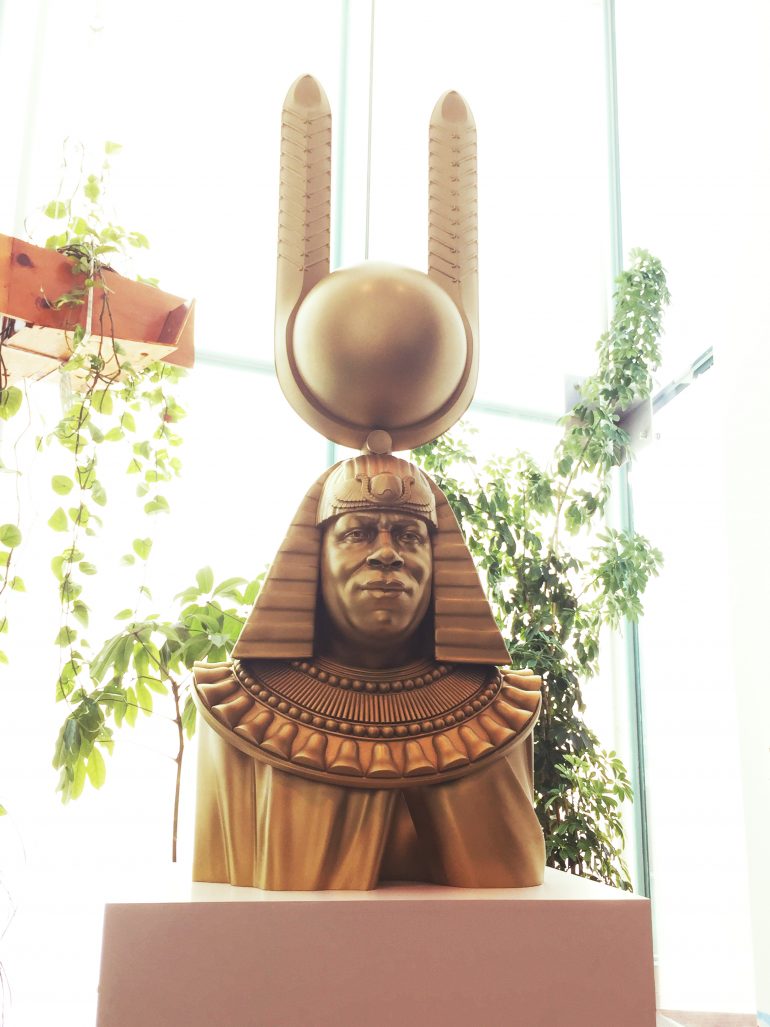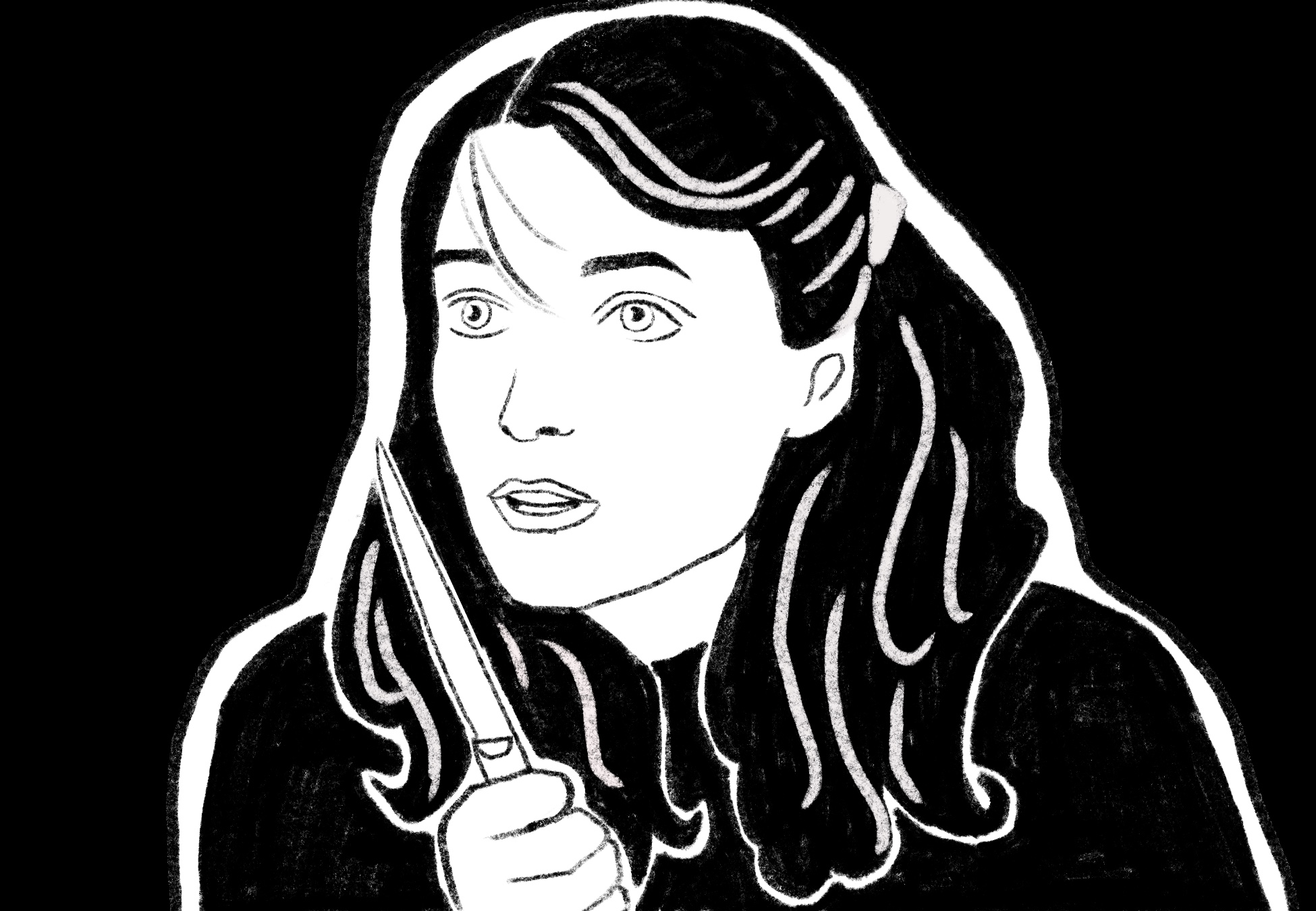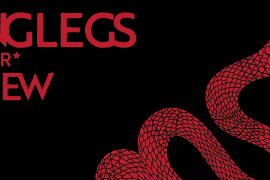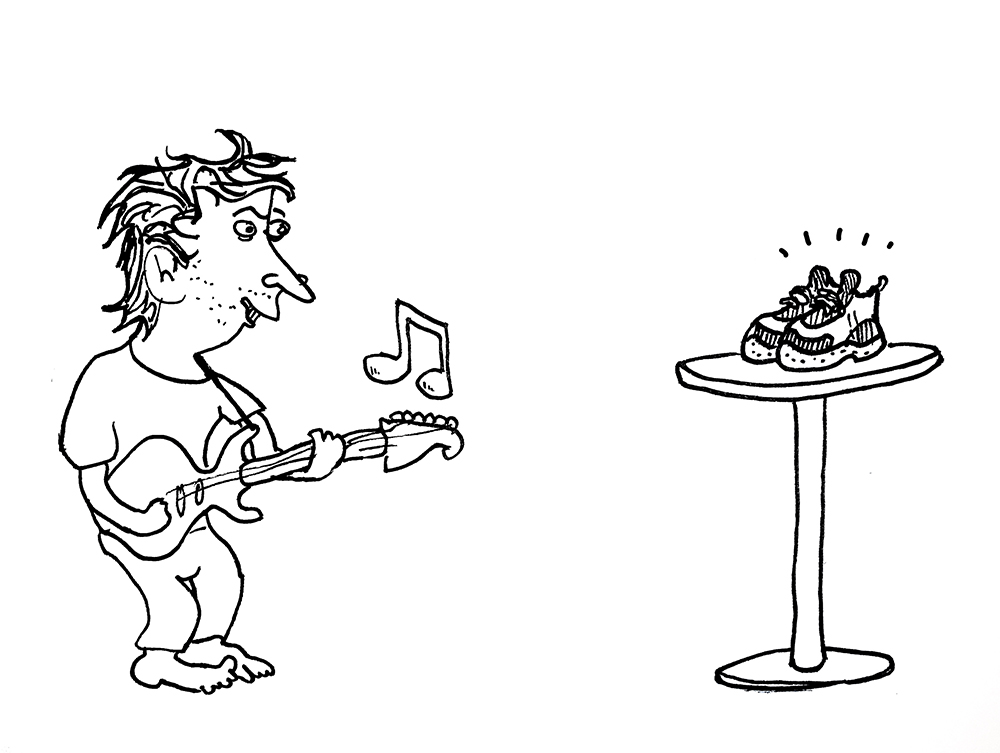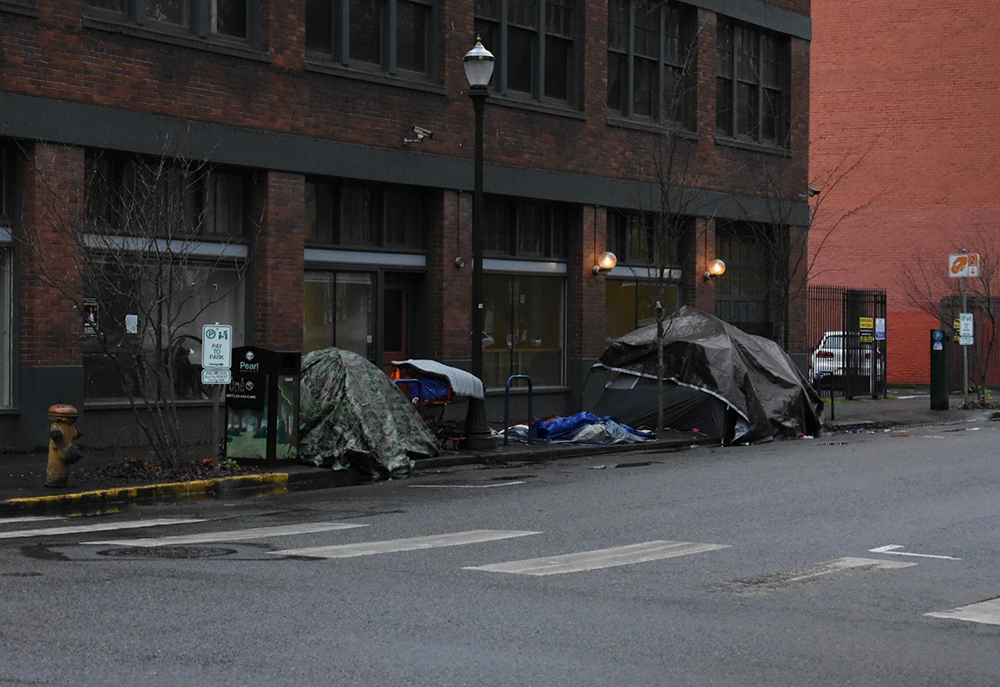Showcasing the expansive wonder of Sun Ra at the Portland Art Museum is no simple task. The show closed out a series of five shows exploring each word in the series’ title: We.Construct.Marvels.Between.Monuments. Each of the shows sought to bring institutional critique to the top floor of PAM’s Modern and Contemporary Art wing. Specifically, visiting artistic director Libby Werbel appears to hold the fine art world’s lack of inclusion at the forefront of the series as a paramount message for visitors, and through very specific programming hoped to make the historically upper-class-straight-white-people atmosphere of an art museum more accessible and inviting to everyone, regardless of gender identities or socio-economic and racial backgrounds.
Werbel brought in cosmic women organizers Deep Underground to assist in providing vision and curation to the Sun Ra exhibit. DUG asserts Monuments is a way to begin the work of elevating Black and Brown thinkers, artists, and musicians to help offset colonial biases of the United States. One of their opening statements also brings up the tendency to thank oppressors for progress toward liberation; specifically referencing Abraham Lincoln freeing the slaves but that, “No. The enslaved people FOUGHT AND DIED to free themselves.”
My first breeze through Monuments didn’t leave me feeling much. I had been to see Marvels when it was around and was really impressed by both the works on display and the concepts and processes that brought them to life. Marvels’ secondary title was notMoMA, a reference to the fact that the works were recreations of works from New York’s Museum of Modern Art. The works were created by high school students who had only seen the works online and produced reproductions with whatever materials available to them in whatever ways made most sense. I wish I didn’t know the work was made by high school students who underwent this process. But if I stumbled across the work from that show in a museum, would I have still been impressed? Which was probably part of the point of the show in the first place: The art world is for everyone—if everyone had that magical access that bridges the gap between Saturday Market and PAM.
At Monuments, I noticed the sweet golden bust of Sun Ra modeled after Space Is the Place surrounded by houseplants, and appreciated the nod to Fred Wilson’s Mining the Museum—in Wilson’s show, several busts of white people existed but there was a noticeable lack of people of color celebrated in sculpture despite people of color doing a lot of noteworthy things. Ra’s bust reminded me of Kehinde Wiley’s sculpture a couple floors below and Wiley’s deliberate work to celebrate Black people through deliberate conversations with, and uses of artistic traditions and classical poses that have not historically included them. Heavy topics but a great choice given the exhibition’s Monuments title. I wandered through the exhibit. I saw some outfits, records, and videos of Sun Ra bein’ a spacey jazz-man. I saw some listening stations, photos, and weird instruments used in Sun Ra’s Arkestra, it was cool, but it felt surface-level and kitschy.
I was familiar with Sun Ra before I came. Not that I knew a ton about his work or had clocked hundreds of hours listening to his discography; but I’d seen videos of Arkestra rehearsals and performances. I’ve spent time around a lot of musicians and knew how prolific and well renowned the spaceman was.
On my second visit, I gave the exhibit more than a surface-level examination and had a much different experience. I came with my BFA class—this translates to: I had to be in the Sun Ra exhibit for nearly two hours. I was forced to take time with the exhibit for about an hour before we would chat with Werbel about the exhibit and the series it is a part of. Sometimes all it takes is the introductory exhibition statement. Sometimes you have to be in the right mood. Maybe for me it was both, who knows.
The legacy of Sun Ra
The legend goes that Herman Poole Blount was born in 1914; but that when Blount traveled to space in 1934, Blount ceased activity. Returning from Saturn came Sun Ra as we know him today. While reading the opening statement, I came across the line: “This exhibition highlights Sun Ra’s idea of an ‘altered destiny,’ a utopian belief that a more meaningful and just world awaits humanity in Outer Space.” My heart sank. Yeah, Ra established the core of his identity in the 1930s and 1940s in the south. He died in 93. War, segregation, oppression, sabotage, of course I would want to look elsewhere for justice if I lived most of my life under those conditions.
My heart sank further. It’s 2019. The United States spent its first hours of the year firing tear gas at migrants who didn’t want to wait months for their asylum claims to be heard. The Lloyd Center Doubletree called police on a Black guest staying at the hotel because he made a phone call in the corner of the lobby; after verifying the man wasn’t loitering, the hotel and police removed the man from the hotel without refunding him the money he paid to stay at the hotel where he was making a call on his cell phone from. The stories always continue and get worse. Two children have died in Customs and Border Protection custody. Earth is maybe not such a great spot. Especially if you’re not rich and white.
“To Sun Ra, Outer Space was not an escapist fantasy—it was a place where society, culture, and systems are reimagined to give power to the oppressed.,” the statement continued. My heart dropped again. Sun Ra’s primary message was to create a more meaningful and just existence for black and brown identities—I didn’t know that, I knew him as the spaceman with a prolific crew of free-jazz musicians who had the chops to blow for hours. In 1934 Ra, landed on the Earth with a message of justice from Saturn for the sake of humanity. 59 years later when he ceased activity on this planet, was he happy? Hopeful? Depressed? Broken-hearted? What does Ra, on whatever dimension or planet he is currently active, think about the state of humanity on Earth in 2019, 26 years after his departure?
Ra had hoped to spread empowerment and “give [Black people] something so they will realize that the Creator hasn’t forgotten them.” This intentionality behind Ra’s art, is what gives the work and the music it’s cosmic power, and probably was the driving force that motivated him to lead his Arkestra with such a feverish need to keep rehearsing. To create like your freedom and the fate of humanity depended on it—all while maintaining a zen like state, perhaps out of necessity to avoid burnout and be able to continue to work for decades.
Putting my nose a little closer to the titles and documents, I read Ra’s application to NASA’s Programs of Artistic Merit In Space, seemed like a perfect match; looking at the hand printed, painted, and drawn record covers, and thinking about what it means to release 228 full length albums in a lifetime; and watching his musicians ask him when they can take a break from rehearsal because they’ve already been going for such a long time, but Ra hardly looks up because the fate of humanity demands that they all push forward.
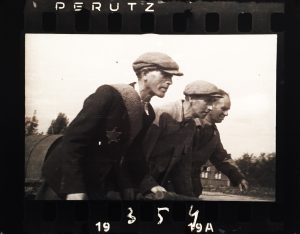
Oppression at the Portland Art Museum
Sun Ra’s quest for justice in the face of United States’ oppression made me think of the different forms and various forms that oppression take. A couple floors below the Ra exhibit is a photography exhibit about life under Nazi rule. Henryk Ross took photographs of life in the Lodz Ghetto in Poland. These photographs are on display at PAM for Memory Unearthed. Some show Jews standing behind barbed wire, working, transporting feces, and in some of the photos seeming to have a good time in spite of it all. Ross was hired to document life in the Ghetto initially, but the mood changed and Ross buried his negatives to be able to show the world what had happened there. Lodz was occupied by the Germans in 1939, 5 years after Ra became active on earth. Initially the Lodz Ghetto contained 160,000 trapped Jewish residents. Only 877 Jews were alive in the Lodz Ghetto when it was liberated in 1945.
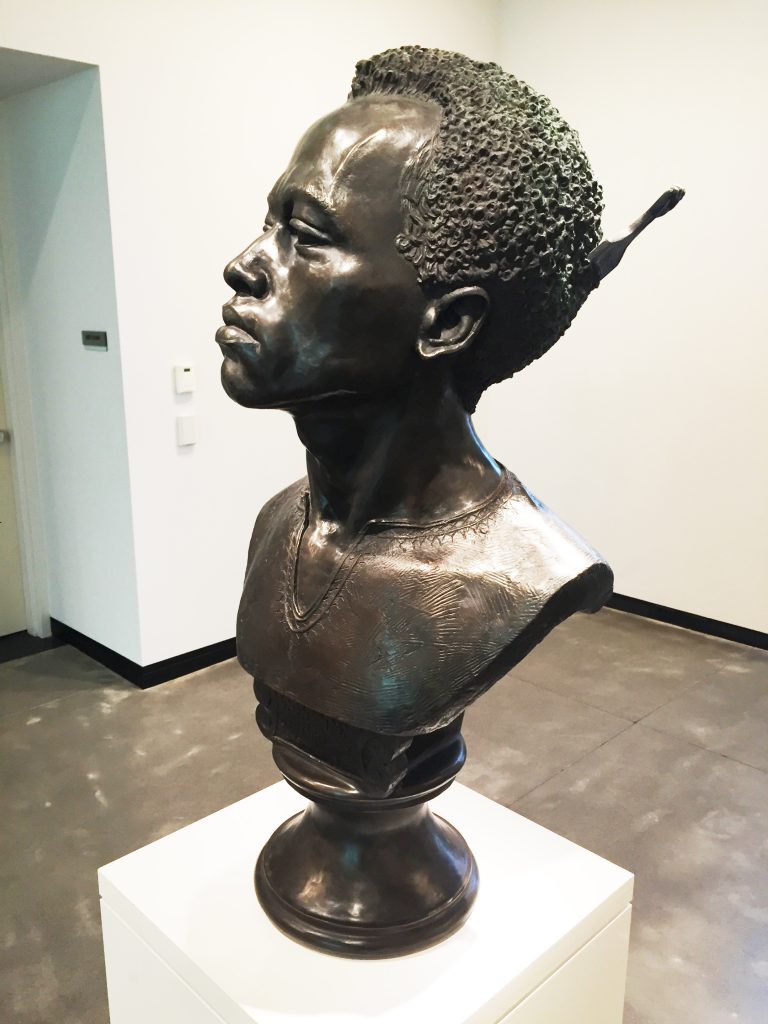
From the 1970s to 1990s over 90,000 Ethiopian Jews migrated to Israel to escape persecution, famine, and war. Unfortunately, although they, too, were Jewish, the Ethiopians ended up finding oppression and racism. leave the country.
Kehinde Wiley’s sculpture at PAM is a bust of one of these Ethiopian Jews. While Wiley was recently in the spotlight for his contemporary painted portrait of President Obama. Wiley met the sculpture’s model in Tel Aviv—Wiley’s portraits tend to showcase normal people, celebrities and political figures are out of the ordinary. Likunt Daniel Ailin has a presence, a skepticality, and a pride. There is a tangible power in Ailin’s face and posture as the statue asks in Hebrew, “What would make it possible for us to live together?” The bust is wearing traditional Ethiopian clothing and has a Black fist hair pick in his hair.
It’s a tough question to answer. But these exhibitions are enlightening. Ross’s photography exhibit features photographs he had to bury for us to see. Sun Ra spent his entire life trying to show Black people that they matter. Part of the funding Werbel was given for this exhibition series went to collaborating with other groups, such as DUG. Sun Ra’s exhibition was largely supposed to be presented in his words or in ways that Ra would have appreciated and agreed with. Like Fazal Sheikh’s affecting show Common Ground, Monuments realized the power of trying to present information better and considering the people. Henryk Ross, Sun Ra, and Likunt Daniel Ailin all have stories to tell and some of them are able to tell the story for themselves. If they’re able to tell their own story, why should we think we’re better spokespeople than the subjects we display in our exhibitions?
Werbel seemed tired. We.Construct.Marvels.Between.Monuments is nearly over after an ambitious year of programing. Coming into this project Werbel, DUG, PAM, and other collaborators had hoped to make the museum feel more welcoming to diverse audiences. Even after getting a broader range of people into the museum, there still seemed to be a problem: bringing people through the door is only half the battle, making people feel comfortable enough to stay is another large piece of the puzzle. Unfortunately, people still have to listen to (typically white) people making insensitive comments once they’re inside—probably not because they want to be malicious, but because they don’t seem to listen when people try to tell them that they’re being insensitive. Experiencing microaggressions doesn’t seem like the sort of environment one enjoys going to to get lost deep in thought. The art world—and the world at large—needs to do better. Hopefully, for Ra’s sake, we can start turning things around this year.
In 1980 Sun Ra said, “A catalyst comes and changes everything, yet it remains unchanged.” 84 years after Sun Ra’s beginnings of earthly activity, we are still waiting for the just universe to arrive; 45 years after Sun Ra began his work, he made that statement. Wherever he is, he’s probably shaking his head right now—and then promptly getting back to recording another couple hundred records.

